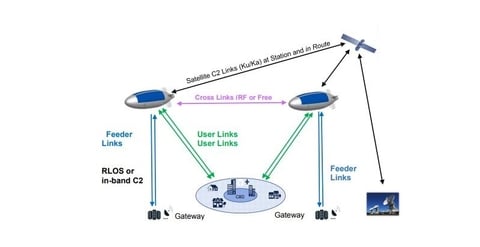The leadership of Elefante Group wants the FCC to know: The U.S. can win the race to 5G if it enables sufficient access to spectrum for Stratospheric-Based Communication Services (SBCS).
If it sounds a little out there, well, it is. As in, the Elefante executives say their lighter-than-air stratospheric platform stations (STRAPS) will have on-board networking capability—a “Network in the Sky” as they call it—that could almost instantaneously make entire markets 5G ready, supporting 4G, 5G and IoT backhaul and densification. Elefante Group airships are envisioned to operate at about 65,000 feet altitude.
The group previously told the commission that it identified the 25.25-27.5 GHz band as a key candidate for stratospheric communication systems. Notably, on the 2019 World Radiocommunication Conference agenda, the larger 24.25-27.5 GHz band is being considered in Region 2, which includes the United States, for High Altitude Platform Stations, or HAPS, a type of stratospheric platform communication system.
Elephant Group CEO Brian Terkelsen and others, including Lockheed Martin executives, recently met with FCC Commissioner Michael O’Rielly and advisors from other commissioners’ offices to provide an update on the technology. (PDF) They want certain spectrum for their plans, including 26 GHz, and are asking the FCC to put their petition (PDF) on public notice.
The advantage of SBCS for the rollout of 5G in urban as well as rural markets are clear, they explained: A single STRAPS’ 15,400-square-kilometer (6,000 square miles) coverage area would inherently cover, in almost all market deployments, both urban and surrounding rural areas.
Elefante Group’s STRAPS are being designed to deliver 1 Tbps broadband infrastructure in each direction to user terminals within a nominally 70 km radius footprint. They’re talking about using this to deliver 4G/5G backhaul, enterprise WAN, residential broadband and sensor and IoT services.

The group is urging the commission to take major steps toward implementing a next-generation network policy by adopting rules for SBCS as well as other platforms, saying that enabling SBCS in a timely fashion will help secure U.S. leadership, stimulate private sector investment in new communications infrastructure and facilitate systems that have the ability to bypass the physical and local regulatory infrastructure challenges that persist.
Of course, they need spectrum. Over the past year, Lockheed Martin and Elefante Group examined spectrum in the U.S. between 17 and 47 GHz to identify suitable bands, taking into account allocations and planned and proposed uses. They actually performed more than 25 compatibility analyses to find the sweet spot, and as a result, they determined that the 22-23 and 26 GHz bands present the most suitable candidates for communications between user terminals and STRAPS to allow SBCS to attain their proposed performance levels. Elefante Group also has plans to deploy STRAPS feeder links in the 70 and 80 GHz bands.
The group is asking the commission to adopt a regulatory framework for SBCS to access spectrum in the 22-23, 26 and 70/80 GHz bands and to govern the operation and licensing of SBCS in those bands.
The 26 GHz spectrum in particular could be challenging. The Elefante Group asked the commission to remove 26 GHz from the Spectrum Frontiers item, saying the 26 GHz band is essential for the introduction of SBCS in the U.S.
But CTIA has urged the commission to move forward on a proceeding that would seek comment on making the 26 GHz band available for flexible, exclusive-use licensing for terrestrial fixed and mobile services—something the FCC will consider at its June 7 meeting when it considers an item about bands above 24 GHz.

